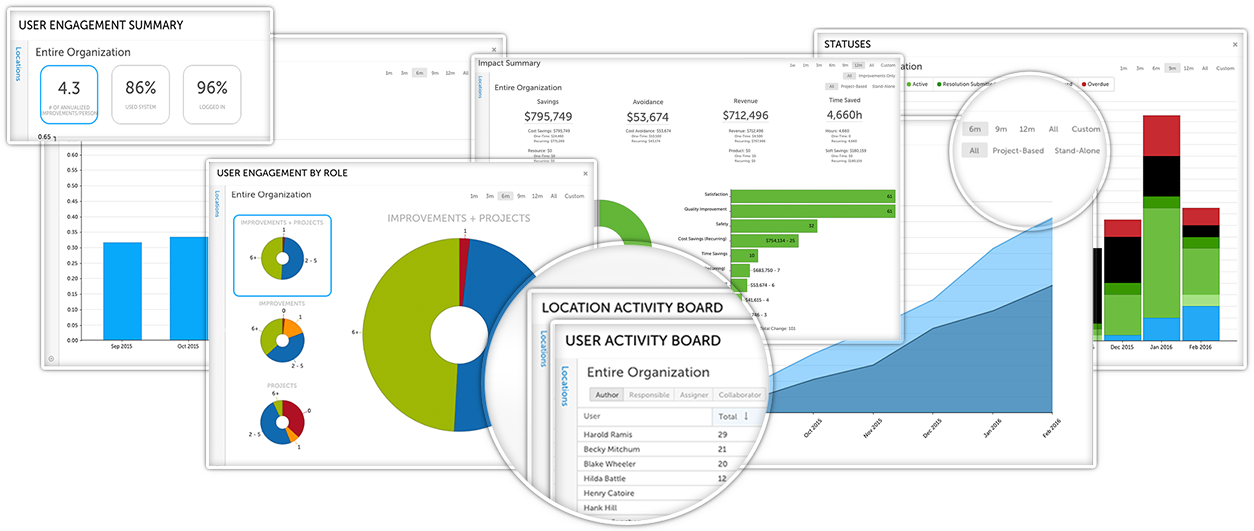 DMAIC is a widely used structured process improvement technique developed at Motorola in the 1980s. It is popular among organizations that use the Lean manufacturing or Six Sigma business methodologies but is also used as a stand-alone continuous improvement tool. It helps teams tackle challenges by finding root causes and applying thoughtful fixes. DMAIC ensures that change is well documented, managed, and successful.
DMAIC is a widely used structured process improvement technique developed at Motorola in the 1980s. It is popular among organizations that use the Lean manufacturing or Six Sigma business methodologies but is also used as a stand-alone continuous improvement tool. It helps teams tackle challenges by finding root causes and applying thoughtful fixes. DMAIC ensures that change is well documented, managed, and successful.
Improvement software is not required to complete a DMAIC process, but there are smart reasons for making it part of your organization’s approach. Technology can help speed up the DMAIC process, it helps to measure the results, and it creates your organization’s repository of knowledge. In fact, software has a role to play during each stage of the DMAIC process. Here’s how it works.
Define
The DMAIC process starts with a thorough account of the business problem or opportunity for improvement at hand. The business impact and significance of the issue are documented in detail. The stakeholders, customers, business units, and processes involved are identified. The team creates a project charter that limits the scope of the project and lists any necessary resources.
Organizations without improvement technology in place are forced to rely on email and spreadsheets to manage this process, creating a lot of opportunity for error, delay, and miscommunication that slows progress down. When improvement software is used instead, all of the necessary documents, task assignments, and discussions are kept in one platform that everyone can access. What’s more, the team can begin the process by searching for similar problems that have been tackled before and see what can be learned from experience, giving them a head start on improvement.
Measure
The measurement step comes before improvement in DMAIC for an important reason. Improvement can’t be quantified unless baseline statistics are in place and the KPIs are understood. During the measurement phase of the DMAIC process, the team reaches a consensus about who will be responsible for process measurements, how frequently the data will be collected, and how it will be shared with the people who need it.
A software platform for improvement management helps teams capture the current state measurements and calculate the short and long-term impacts of the change. The effect of all DMAIC projects can be rolled up to give leaders the big picture on how much continuous improvement is contributing to the bottom line or other strategic objectives.

Analyze
The next phase of the DMAIC process is about looking at the problem statement and the measurements to find the root causes of process breakdowns and vet potential solutions. There are several visual management tools, including control charts and value stream mapping that are helpful techniques for finding choke points and waste. At this point, the team evaluates and decides on a course of action for testing potential improvements.
The improvement software solution becomes the home for all of the potential opportunities for improvement, even the ones that aren’t going to be implemented at this time. That way, they live on for future consideration. This is another good time to review past improvements to see what has worked well (or not) before.
Improve
It’s worth noting that “Improve” is the fourth step in the five-step DMAIC process. That’s because the point of DMAIC is controlled change, not action based on guesses or gut-feelings. Only after careful analysis is the improvement plan put into action. Experimentation and testing occur until a new Standard Work is introduced to those who operate the process.
Improvement technology allows the team to make assignments and track activities during the improvement process. Look for a system with automated notifications and alerts to ensure forward momentum. It should also have dashboards and other visual management features, such as Kanban and huddle boards to help teams track their efforts and leaders monitor the progress of improvement work across all groups.

Control
The last step of the DMAIC process, control, is a big reason why so many organizations find it useful. The process doesn’t end when the change is implemented. Instead, teams monitor and measure the results over the long run. The KPIs that were developed in the measurement phase are now top of mind. Teams also are vigilant, looking for any unintended results of the change.
Of course, all of this data collection is streamlined with improvement software. Not only does it contain useful tools such as control charts and other graphs, but it also makes it easy to broadcast the results of the DMAIC process and spread the desire for improvement across the organization.
We talk to leaders every day who are amazed at what their teams can accomplish with the combined power of DMAIC and technology. Given these synergies, it’s easy to see why.



Add a Comment